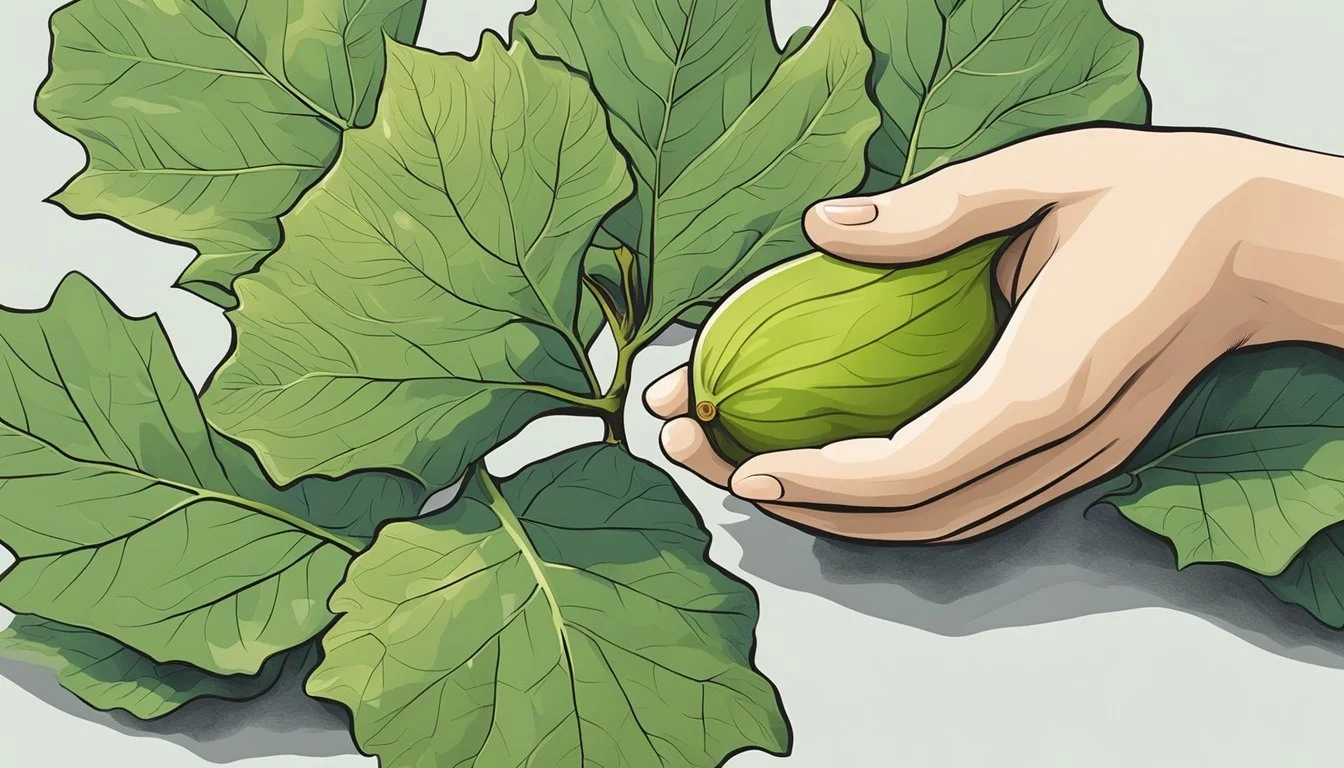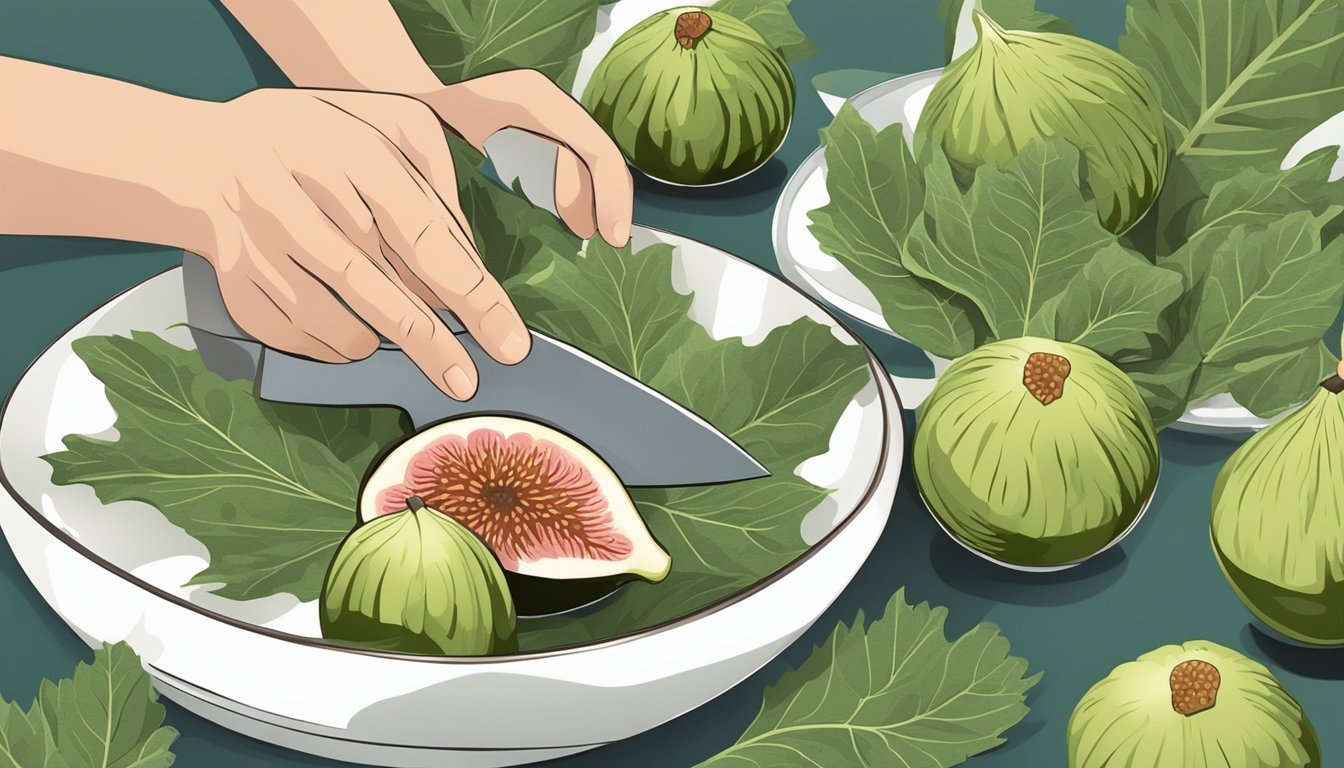Fig Leaves Substitutes
Best Alternatives for Recipes
Finding substitutes for fig leaves can be challenging, but there are several effective alternatives to consider. Grape leaves are a versatile and widely recommended substitute, perfect for use in baking and wrapping foods. They bring a mild, slightly tangy flavor that complements many recipes.
For salads and snacking, you can turn to ingredients like spinach leaves or even cabbage leaves, which offer a similar texture and visual appeal to fig leaves. While the flavor is different, these substitutes still provide a fresh and crisp element to dishes.
In recipes where the unique characteristics of fig leaves are essential, such as in Mediterranean or Middle Eastern cuisine, additional alternatives like Swiss chard may be used. Swiss chard provides a comparable consistency and can be used in a variety of culinary contexts, making it a good stand-in for fig leaves.
Understanding Figs
Figs come in various types, each with unique flavors and nutritional benefits. Knowing how to choose and use figs can enhance one's culinary experiences and provide valuable nutrients.
Varieties of Figs
Figs are available in multiple varieties, each offering distinct flavors and uses. Black Mission figs are one of the most popular types, known for their sweet, rich flavor. Kadota figs have a lighter color and taste, making them suitable for drying. Brown Turkey figs are versatile, offering a balanced flavor that works well in both fresh and dried forms. Each variety can be used in different culinary applications, from fresh snacks to dried fig recipes.
Nutritional Profile
Figs are not only delicious but also nutrient-dense. They are a good source of dietary fiber, which aids in digestion. Fresh and dried figs contain essential vitamins and minerals such as potassium, iron, and calcium. These nutrients support various bodily functions. Fresh figs have fewer calories per serving compared to dried figs due to the absence of concentrated sugars found in dried versions, making them a healthier option for weight management.
Fig Season and Selection
The peak season for fresh figs generally runs from late summer to early fall. When selecting fresh figs, look for fruits that are plump, tender, and free from bruises. They should have a slight give when gently pressed. Dried figs are available year-round and can be used as a substitute for fresh figs in most recipes. They provide similar nutritional benefits but with a more concentrated sweetness. Proper storage of figs, whether fresh or dried, is essential for maintaining their quality and flavor.
Culinary Uses of Figs
Figs offer versatility in cooking, both in sweet and savory dishes. Their unique flavor profile and texture make them suitable companions to various ingredients, enriching culinary endeavors.
Common Fig Pairings
Figs pair well with a variety of ingredients, enhancing both savory and sweet dishes. When preparing a cheese platter or charcuterie board, figs can be served alongside blue cheese, brie, or goat cheese for a delightful combination. Nuts such as almonds, walnuts, and spices like cinnamon and nutmeg also complement figs beautifully.
In desserts, figs match perfectly with honey and dark chocolate. For savory applications, figs can be partnered with prosciutto, pork, or included in salads with arugula and balsamic vinegar. Fig jam is a popular condiment, adding depth to sandwiches and meat dishes.
Cooking Techniques
Figs can be used in various cooking methods, each bringing out different facets of their flavor. Baking figs, for instance, caramelizes their natural sugars and softens their flesh, making them ideal for tarts, cakes, or bread. Braising figs with a bit of wine or stock enhances their sweetness and creates a rich, syrupy sauce.
When roasting, figs take on a deeper flavor, pairing well with meats like chicken or lamb. For a simpler approach, fresh figs can be sliced and used raw in salads or on cheese and charcuterie boards. Fig jam, whether homemade or store-bought, offers a convenient way to incorporate fig flavor into various dishes like sandwiches and glazes.
Choosing Fig Substitutes
Choosing the right substitutes for figs depends on the specific recipes and whether fresh or dried figs are required. Different types of substitutes can provide unique flavors and textures, enhancing your dishes in various ways.
Substitutes for Fresh Figs
When replacing fresh figs, consider fresh apricots, peaches, nectarines, or strawberries. These fruits provide a similar sweetness and moisture level necessary for many recipes. Fresh apricots and peaches are particularly suitable for salads, charcuterie boards, or as an add-in for desserts. Nectarines, with their firm texture, work well in both savory and sweet dishes.
Strawberries offer a slightly different but equally appealing sweetness. They can be used in salads, parfaits, or simply as a fresh snack. The high water content and bright flavor make them a versatile substitute for fresh figs.
Substitutes for Dried Figs
For dried figs, excellent substitutes include dried apricots, prunes, dates, raisins, and cranberries. Dried apricots provide a tangy sweetness that works well in baked goods and savory dishes. Prunes are noted for their deep flavor and fibrous texture, making them an appropriate choice for stews, braised dishes, and baked goods.
Dates, especially Medjool dates, are a popular alternative due to their caramel-like taste and larger size. They can be used in energy bars, salads, and sauces. Raisins—both brown and golden—offer a sweet, fruity flavor, suitable for cookies, breads, and meats. Lastly, cranberries provide tartness and can be used in place of fig syrup in some recipes.
Fig Substitutes in Baking
When baking, substitutions for figs should maintain both flavor and moisture. Prunes and dates are highly recommended for their rich, sweet flavor and moisture. Prunes can be finely chopped or pureed to blend seamlessly into batters and doughs. Dates, especially when pureed, add natural sweetness and a pleasant chewiness to cakes and cookies.
Raisins can also be used, particularly in recipes like fruitcakes and breads where their texture complements other ingredients. Cranberries—dried, fresh, or frozen—add a unique tart flavor and a lovely contrast to sweet baked goods.
For recipes requiring fig jam, using honey or sugar mixed with quince paste or apricot preserves can mimic the texture and sweetness of fig jam. These combinations work well in pastries, cakes, and spreads.
Non-Fruit Altern's and Enhancers
While figs provide a unique taste and texture, non-fruit substitutes and enhancers can also replicate some qualities, bringing distinct flavors and benefits to dishes. These alternatives can include specific nuts, seeds, sweeteners, and spices to enrich the culinary experience.
Nut and Seed Options
Nuts and seeds offer a complex combination of crunch and flavor. Walnuts, for instance, are robust and slightly bitter, pairing well with savory dishes and salads. Almonds, lighter and sweeter, work wonderfully in both baked goods and as a crunchy topping.
Pistachios add a vibrant green color and a mild, sweeter taste, making them suitable for both desserts and savory concoctions. Sunflower seeds provide a nutty flavor and softer crunch while being an excellent addition to salads, cereals, or even as a crust for meats.
Sweeteners and Spices
To mimic the sweet and complex flavor profile of figs, honey stands out as a natural sweetener with floral notes. It melds seamlessly into dressings, glazes, and baked goods. Maple syrup offers a unique caramel flavor that can enhance both desserts and savory dishes.
For spices, cinnamon and nutmeg bring warmth and depth. Cinnamon, with its sweet and woody nuances, is versatile in both sweet and savory recipes. Nutmeg adds a slightly spicy and nutty note, perfect for enriching sauces, marinades, and baking.
Other enhancers like sugar provide straightforward sweetness, while combining them with spices can elevate the overall flavor profile of any dish. Using these alternatives thoughtfully can create equally delightful and complex culinary creations.
Complementary Foods for Fig Substitutes
Fig substitutes can pair excellently with various foods, enhancing taste and culinary presentation. From cheese boards to salads and mains, as well as desserts, these complementary additions will elevate your dishes.
Suitable for Cheese Boards
When incorporating fig substitutes like dates, quince, and apricots into cheese boards, they complement the flavors of blue cheese, goat cheese, and brie. Nuts such as walnuts and almonds add a crunchy texture. Adding a drizzle of honey can enhance the sweetness.
Consider including cranberry juice or lemon juice if you want a tangy contrast. These pairings will create a balanced mix of sweet, savory, and tangy flavors that appeal to a variety of palates.
Enhancing Salads and Mains
To elevate salads, replacing figs with golden raisins, cranberries, or prunes brings a lively sweetness. Citrus fruits like oranges and lemons can provide a refreshing boost. Use lemon juice for an acidic touch that brightens the dish.
For main courses, pancetta works well with these substitutes, especially in chicken or lamb dishes. Incorporating nuts adds a layer of complexity and satisfying crunch.
Desserts and Sweet Treats
In desserts, substitutes such as prunes, dates, and apricots can be used in various recipes like pies, tarts, and puddings. Fig jam can be replaced with apricot or peach jam in pie fillings and sweet treats for a similar richness.
To enhance the sweetness and complexity, pair these substitutes with honey. Adding a touch of citrus zest or lemon juice can balance the sweetness and add a refreshing note to the desserts, making them even more delightful.
Health Considerations
Fig leaf substitutes offer various health benefits, primarily due to their nutritional content and impact on digestive health. This section will dive into the specific ways these substitutes can support your well-being.
Dietary Fiber and Digestive Health
Fig leaf substitutes, like prunes and dried apricots, are rich in dietary fiber. Fiber is essential for maintaining optimal digestive health. It aids in bowel regularity and prevents constipation.
Prunes are particularly well-regarded for their high fiber content, which is beneficial for the digestive system. Dietary fiber helps in regulating blood sugar levels, which can be essential for managing diabetes. Additionally, consuming fiber can also contribute to a feeling of fullness, which aids in weight management.
Soluble and insoluble fibers from these substitutes positively affect gut bacteria. Soluble fiber ferments into beneficial short-chain fatty acids, while insoluble fiber adds bulk to stool, facilitating easier passage. For individuals aiming to improve digestive health, incorporating these fibrous substitutes is a prudent choice.
Vitamins and Minerals
Many fig leaf substitutes are abundant in essential vitamins and minerals. Vitamin A is prominent in dried apricots, playing a significant role in eye health and immune function. Potassium, found in prunes and dates, helps regulate fluid balance, muscle contractions, and nerve signals.
Calcium and magnesium are vital for bone health and muscle function. Prunes provide these minerals in moderate amounts, assisting in maintaining strong bones. Additionally, iron from dried fruits supports red blood cell production, crucial for preventing anemia.
Magnesium also aids in energy production and enzyme function. The array of vitamins and minerals in these substitutes ensures that they contribute to overall well-being, making them not just good alternatives but also beneficial dietary items on their own.







